Tobias is a four-legged lifesaver who has become quite the internet sensation after showcasing his special skills, sniffing out any issue his favorite human might face and ensuring their safety and well-being, all while being the goodest of boys.
The canine hero is a three-year-old American Dobermann Pinscher, and thanks to his handler’s impressive training discipline, he has amassed nearly 160,000 followers on Instagram and almost 37,000 fans on TikTok.
But Tobias isn’t just a social media influencer. His real job is much more important than that. In fact, the black and rust guardian is a certified medical service dog.
“He is scent-trained to alert to upcoming spikes in heart rate and drops in blood pressure, which causes fainting, dizziness, tremors, and more,” Happy Escobar, Tobias’ owner, explained.
Happy is a 26-year-old maintenance worker who has been a handler for over a decade. They were born to a Hispanic American family in Texas, USA, but now lives on an island off the coast of Washington.
Meet Tobias, the internet sensation and medical service dog who ensures his owner’s safety with his special skills
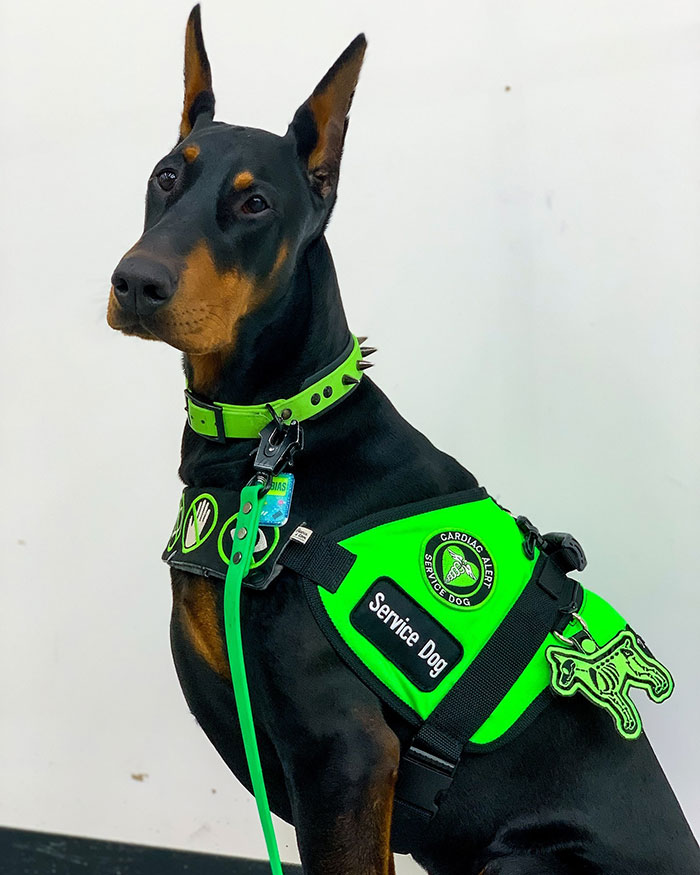
The canine expert, who sometimes goes by “The Kid,” lives with postural tachycardia syndrome (POTs) and Ehlers-Danlos syndrome (EDs), part of their neurodegenerative condition called dysautonomia.
POTs is a condition that causes a number of symptoms when you transition from lying down to standing up, such as a fast heart rate, dizziness, and fatigue, Cleveland Clinic explains.
EDs are a group of rare inherited conditions that affect connective tissue, as per the NHS. The conditions can cause several symptoms, including joint pain, extreme tiredness, and problems with bladder control.
For Happy, the conditions affect their non-voluntary bodily functions, such as their blood pressure, heart rate, and breathing.
“This is a chronic illness, and the only treatment is management,” the maintenance employee who works 12-hour shifts explained. “One of the most versatile and proactive management systems available was a medical alert dog.”
The three-year-old Dobermann assists Happy Escobar, who lives with a neurodegenerative condition called dysautonomia
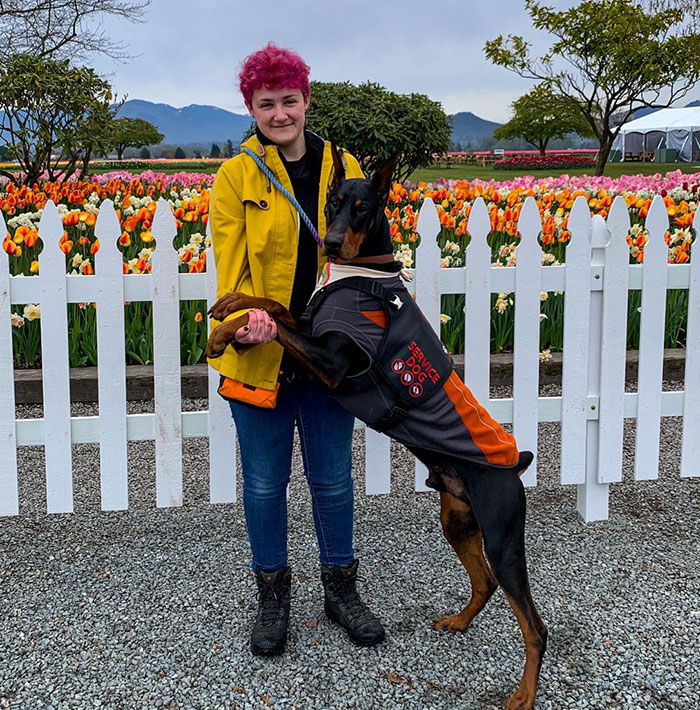
According to Happy, Tobias has been trained to alert to migraines and in mobility tasks, such as counterbalancing to help them walk steadily, opening doors, turning lights on and off, as well as retrieving items.
“Tobias is not only an invaluable aspect of my day-to-day health, but he is my best friend,” Happy told Bored Panda in an email. “Even on the worst health days, he always makes me laugh.”
Tobias keeps Happy from getting injured, such as getting a concussion, in exchange for kisses and a toy toss.
In fact, the intelligent pooch keeps a close eye on his favorite toy — a stuffed shark named Frank.
The astute canine companion was carefully selected from a pool of thirteen puppies for service work, standing out as one of only two with the ideal temperament for the job.
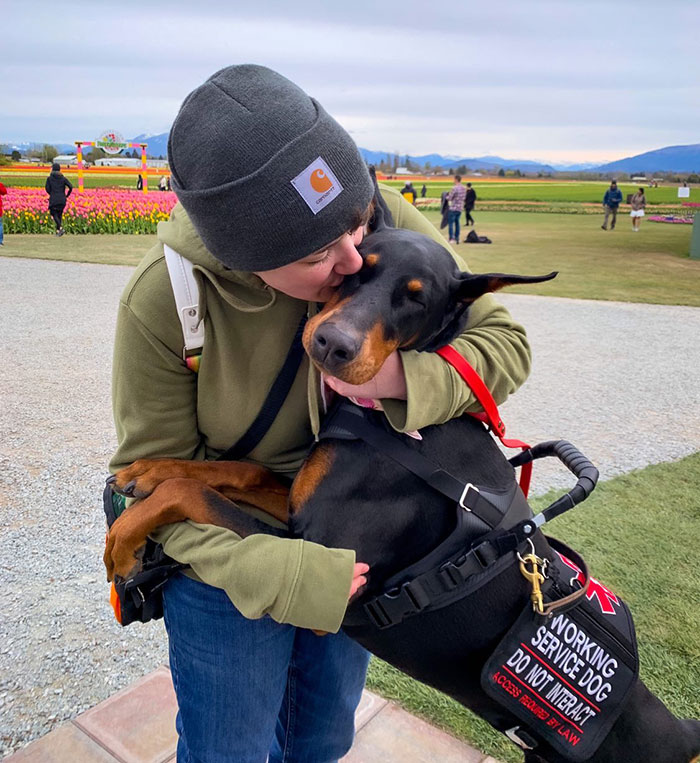
Prior to Tobias, Happy was medically assisted by Jake, an Australian cattle dog/Australian shepherd mix, who has since retired, and at his golden age of 12, he is now living “out his days being very loved and spoiled.”
When Jake turned around nine years old and it was time for him to retire, Happy was looking for a tall, strong, high-energy breed.
“We are away from home 12 hours a day, five days a week,” they revealed. “I needed a dog that could not only work those hours but have energy left over.”
When people think of service dogs, they often envision golden retrievers or labradors, two breeds that are typically smart and sociable. But Happy wanted a dog with less inclination toward engaging with other people.
“A Doberman hits all the marks,” the social media influencer emphasized.
Happy described the breed as fiercely caring, intelligent, and aloof with strangers and other animals but highly driven to work and please.
Happy chose a Dobermann for their service dog due to their unique combination of intelligence, aloofness, and strong work ethic
@thatkidwiththedog Tobias is a medical alert dog who is trained to smell the chemical changes in my body in relation to my contortion , which is called Dysautonomia (POTs). This is a dysfunction of the nervous system which controls non voluntary body functions such as heart rate, blood pressure, gastrointestinal function, urinary system and even breathing and temperature regulation. What he’s alerting to is an elevation in heart rate , followed by a sudden drop in heart rate which causes a drop in blood pressure which can cause fainting. He’s a very good boy! These clips were captured over the course of two years- while he alerts frequently, i am normally more focused on preparing for an episode then i am recording , so getting something on camera is a rare treat. But now that we are doing more free hand recordings , i should catch more ! #doberman #dobermans #servicedog #servicedogs #dogsoftiktok #funnydogs #dogswithjobs #medicalalertdog #dobermanpinscher #chronicallyill ♬ original sound – Happy Escobar
According to Neuropsychological Researcher Stanley Coren’s The Intelligence of Dogs, the Dobermann ranks fifth as the most intelligent dog in the category of obedience command training.
“The Doberman has long been used as a working dog in America, from serving in our wars to being some of the first guide dogs in our country,” Happy said.
Glenn S. Staines of Detroit, Michigan, pioneered the use of Dobermanns as guide dogs for the blind in the 1930s, establishing Pontchartrain Kennels and training over 1,000 Pathfinder Dobermanns to assist visually impaired individuals before his passing in 1951, as per the American Dobermann Pinscher Education Foundation.
“At their core, the Doberman is the only breed of dog created solely for working alongside a human,” Happy explained. “They were not bred to hunt, [and] they were not bred to herd or pull sleds. They were bred to protect their people.”
Karl Friedrich Louis Dobermann, a German tax collector, created the Dobermann Pinscher breed in 1870 to protect him, The Doberman Rescue League states. It is believed the breed originated from a mix of cattle and shepherd dogs. In 1895, the dog was mixed with the Manchester terrier, and at the beginning of the 20th century, the Greyhound bloodline was introduced.
As a guarding breed, Dobermanns’ strength can also be their greatest challenge in training.
According to Neuropsychological Researcher Stanley Coren, the Dobermann ranks fifth as the most intelligent dog
Happy explained: “Their fierce loyalty to their person tends to cause them to be overly protective, which is not a permissible trait in service dogs.
“They can suffer from separation anxiety and a general nervousness if not socialized correctly.
“They are smarter than most and are aware of it, and they will let you know that in many creative ways.
“They need around three hours of physical exercise a day as well as plenty of mental stimulation, not to mention emotional needs as well.
“They have an excellent memory and will remember your mistakes for a long time.
“They need a sure-footed, well-versed handler. They make excellent service dogs for a very specific type of person.
“They excel in the difficult work and struggle with the simple things.”
“At their core, the Doberman is the only breed of dog created solely for working alongside a human,” Happy said
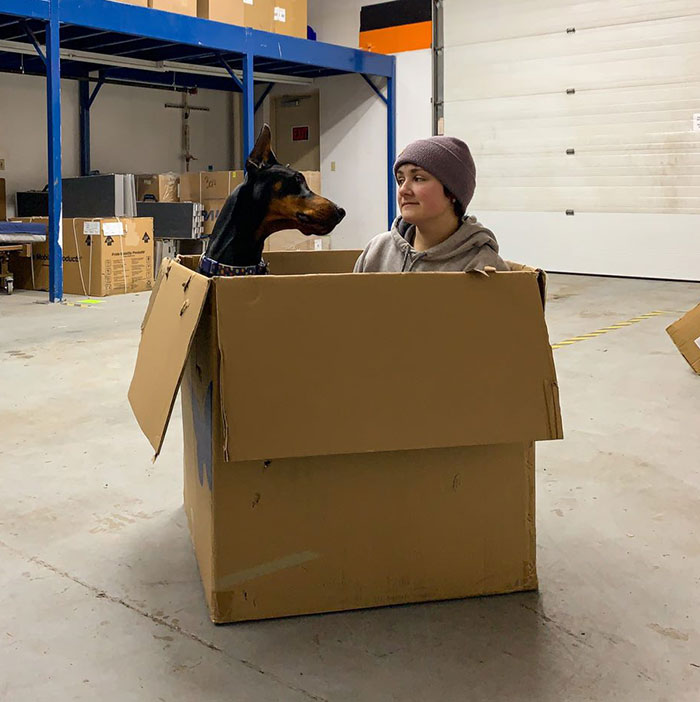
Tobias started his training to become a medical service dog with his breeder when he was just a few weeks old.
When he was a puppy, his training consisted of being exposed to scents, textures, and sounds as his eyes and ears started to open.
“At a young age, he learned all about the big wide world and learned how to just be a dog,” Happy said. “Once he understood how to be a good dog, then his service dog training really started.”
Tobias and his owner spent hundreds of hours working on his public access skills, tirelessly practicing in diverse environments and weather conditions.
Now a medical assistant expert, Tobias’ help enables Happy to brace themself or prepare themself for escalating attacks from their health conditions.
“When he alerts me to an upcoming spike in my heart rate, I know that I need to sit down and try to regulate myself to avoid fainting,” Happy explained. “I will sit down, and if I am able, I will prop my feet up above my heart to keep blood from pooling in my feet.”
Tobias and Happy spent hundreds of hours working on his public access skills
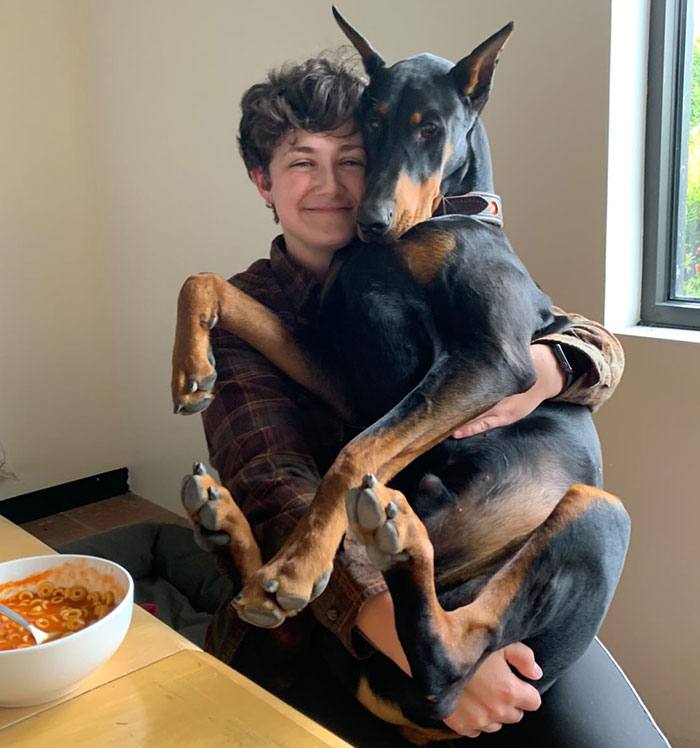
They continued: “Tobias will also either sit on me and put pressure on my vagus nerve in my neck, or if I am already feeling faint, he will stand and block my body with his own, keeping me upright by bracing his weight into me.
“If I drop to the floor from standing, he will actually bark to call people over to assist me.”
As a medical alert dog, Tobias does not adhere to traditional on/off training like a guide dog.
Moreover, the clever pup alerts and performs tasks at home when off duty and remains vigilant even during playtime.
Nevertheless, Tobias also responds to verbal commands to switch between work mode and relaxation mode.
“One of my favorite moments in Tobias’ career is when he started to stop playing to come over and alert,” Happy recalled. “He has even woken up from sleep to alert me to an upcoming episode.”
“If I drop to the floor from standing, he will actually bark to call people over to assist me,” Happy explained
@thatkidwiththedog Such a cool moment to see his training work even when he is having a blast outside! Tobias is a 3 year old medical alert dog trained to alert to my medical condition (dysautonomia) , He has been scent trained to detect chemical changes in my body that are carried on my breath, specifically when my heart rate has a dramatic increase and decrease in BPM which causes my blood pressure to drop which causes fainting. #servicedog #servicedogs #dogswithjobs #medicalalertdog #doberman #dobermanpinscher #servicedoglife #chronicallyill ♬ original sound – Happy Escobar
They further recounted: “To him, it’s just another fun game.
“As anyone who works with dogs knows, it takes a lot of time and training to get a dog to choose to stop doing something fun, like playing, to do their job.
“It is always a proud team moment to see all our hard work pay off.”
Dobermanns are often stereotypically depicted as intimidating and aggressive, as seen in Hollywood portrayals, such as the iconic Zeus and Apollo from the 1980s show Magnum, P.I.
As a result of the negative image, Happy anticipated adverse reactions. But despite occasionally encountering a person who would be “petrified” at the sight of the duo, they’ve received more compliments than critics.
“In his three years, we have only faced one access denial at a restaurant that insisted he needed registration papers,” Happy said.
As per the Americans with Disabilities Act, trained service dogs are not required to be certified or go through a professional training program, and they are allowed to be with their person even in places that don’t allow pets.
The Act further forbids someone from requesting any documentation that the dog is registered, licensed, or certified as a service animal, as well as asking the dog to demonstrate their task or inquire about the nature of the person’s disability.
“While he is not very good at it, he loves to swim,” Happy described Tobias
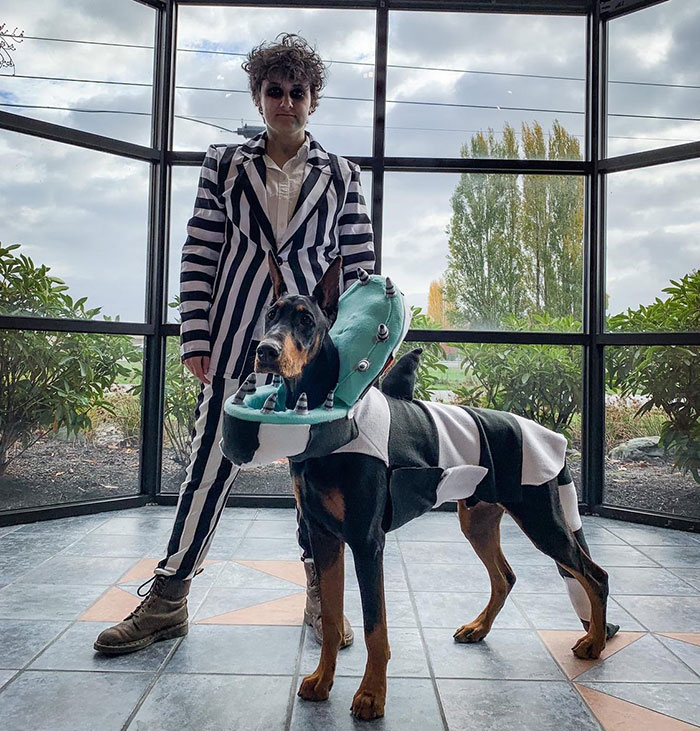
Happy continued: “We have people stop us about every ten feet in the store to remark on his good behavior, his good looks, or even asking us for pictures.
“People adore him. The only time we face any negativity is online, where all arrogant ignorance lingers.”
As it happens, Happy’s primary challenge with Tobias has been addressing a debated phenomenon within the guard dog community known as the “Dobermann whine.”
“The Doberman is known to be vocal, not necessarily [by] barking but crying,” Happy noted. “The tea kettle whine is constant. They are very opinionated.”
They further explained: “They will cry for every reason, even for no reason.
“It’s just what they do. It takes a lot of work and patience to minimize that.
“Getting them to settle can also be difficult because they want to do everything at ten thousand miles per hour.”
In between work and whines, Tobias likes spending time at the beach, as his owner admitted: “While he is not very good at it, he loves to swim.”
Before Tobias, Happy relied on Jake, an Australian shepherd mix, who has since retired and is now just being spoiled

Happy acknowledged that their sharp-witted companion “has a strange fascination with anything from the ocean and a bizarre vendetta against cardboard boxes.”
They added: “His favorite movies are any of the Indiana Jones movies and, specifically, Jurassic Park 2.
“He also loves to watch Martha Stewart on lazy Sunday mornings, usually while he is in his pajamas and wrapped in a blanket.
“Oddly enough, he loves peppers. Though we only let him eat sweet peppers, he tries his very hardest to even eat spicy ones like jalapenos and serrano peppers. It’s one of the only things he will drool over.”
Tobias keeps Happy from getting injured, such as getting a concussion, in exchange for kisses and a toy toss
@thatkidwiththedog He picked it out himself 🐘 #servicedog #servicedogs #dogswithjobs #medicalalertdog #doberman #dobermanpinscher #servicedoglife #funnydog #dogsoftiktok ♬ Sneaky Friends – Eitan Epstein Music
Ultimately, service dogs work their entire life to do their job, Happy said, stressing that it takes a lot of time and money to train them.
“Please don’t make their job more difficult,” the dog expert underscored. “Be an ally to working animals, and leave your pets at home when going into non-pet-friendly establishments.”
Doberman Tobias Goes Viral For Incredible Ability To Detect Range Of Health Emergencies Bored Panda






